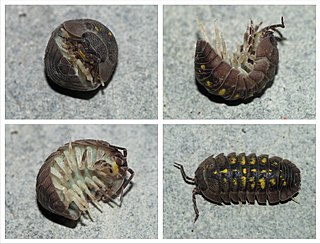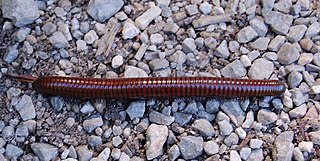
Armadillidium is a genus of the small terrestrial crustacean known as the woodlouse. Armadillidium are also commonly known as pill woodlice, leg pebbles, pill bugs, roly-poly, or potato bugs, and are often confused with pill millipedes such as Glomeris marginata. They are characterised by their ability to roll into a ball ("volvation") when disturbed.

Pygidicranidae is a family of earwigs, formerly placed in the suborder Forficulina, now in the suborder Neodermaptera. The family currently contains twelve subfamilies and twenty six genera. Eight of the subfamilies are monotypic, each containing a single genus. Of the subfamilies, both Astreptolabidinae and Burmapygiinae are extinct and known solely from fossils found in Burmese amber. Similarly Archaeosoma, Gallinympha, and Geosoma, which have not been placed into any of the subfamilies, are also known only from fossils. Living members of the family are found in Australia, South Africa, North America, and Asia. The monotypic genus Anataelia, described by Ignacio Bolivar in 1899, is found only on the Canary Islands. As with all members of Neodermaptera, pygidicranids do not have any ocelli. The typical pygidicranid bodyplan includes a small, flattened-looking body, which has a dense covering of bristly hairs (setae). The pair of cerci at the end of the abdomen are symmetrical in structure. The head is broad, with the fourth, fifth and sixth antenna segments (antennomeres) that are not transverse. In general Pygidicranids also have equally sized ventral cervical sclerites, and in having the rearmost sclerite separated from, or only touching the center of the prosternum. Cannibalism of young has been observed in at least one species in the family, Challia hongkongensis, in which an adult female was found eating a still-living nymph of the same species. The same species in a different area has been observed possibly eating fruits or seeds, making the species an omnivore.

Lithobius is a large genus of centipedes in the family Lithobiidae, commonly called stone centipedes, common centipedes or brown centipedes.
Calconiscellus is a genus of crustacean in family Trichoniscidae. One species, C. gotscheensis, is listed as vulnerable on the IUCN Red List.

Haplophthalmus is a genus of woodlice in family Trichoniscidae. It contains 47 described species, of which two are listed as vulnerable species on the IUCN Red List – Haplophthalmus abbreviatus and Haplophthalmus rhinoceros.

Scutigeridae is a family of centipedes. It includes most of the species known as house centipedes, including Scutigera coleoptrata and Allothereua maculata.

Diplatyidae is a family of earwigs in the suborder Neodermaptera. It contains only one subfamily, Diplatyinae, which contains six genera, five modern and one extinct known from fossils. The genus Tytthodiplatys was described in 2011 from a fossil found in Burmese amber which dates to the Albian age of the Cretaceous. It was not placed into the subfamily Diplatyinae, and is the oldest confirmed member of the family.

Ligidium is a genus of woodlice. It contains approximately 46 species, six of which are probably taxonomic synonyms of Ligidium hypnorum or Ligidium germanicum. Of the remainder, eight species are found in North America, six in Japan, two in Taiwan, four in China, twelve in Turkey, the Caucasus and Central Asia, and six in Greece.

Xystodesmidae is a family of millipedes. Its members often have very small distributional areas, with many species only known from a single locality. They are found across the northern hemisphere, with peak diversity in the Appalachian Mountains, where one-third of the 300 or so species occur. They are particularly abundant in deciduous broadleaf forests in the Mediterranean Basin, Africa, Asia, Central and North America, and Russia. Information on basic taxonomy is scant for this family; for example, it is estimated that the genus Nannaria contains over 200 species, but only 25 have so far been described.

Trachelipus is a genus of woodlice in the family Trachelipodidae, containing the following species:

Pachyiulus is a genus of julid millipedes containing the following species:

Robert Latzel was an Austrian myriapodologist and entomologist who published a series of pioneering works on millipedes, centipedes, and allies. His collection of myriapod specimens, today housed in the Natural History Museum of Vienna, includes many type specimens. His monographs on the myriapods of the Austro-Hungarian Empire were the first comprehensive treatments of the large region's centipede and millipede faunas. He named nearly 130 taxa of millipedes and over 40 centipede groups, as well as four taxa each of pauropods and symphylans. His work on millipedes pioneered the use of gonopods in millipede classification and species recognition. At least three authors have honored Latzel by naming a genus Latzelia.
Anethoporus is a genus of spirostreptid millipedes native to northern South America, where they range from Peru to the islands of Trinidad and Tobago. The genus and type species, A. clarki, was established by Ralph V. Chamberlin in 1918.

Armadillidae is a family of woodlice, comprising around 80 genera and 700 species. It is the largest family of Oniscidea, and one of the most species-rich families of the entire Isopoda. Armadillids generally have a strongly convex body shape, with some rather shallowly convex. Like members of the woodlice family Armadillidiidae, armadillids are capable of enrolling into a sphere (conglobation), and are commonly known as pill bugs. Armadillids differ from the Armadillidiidae in that the antennae are fully enclosed within the sphere.
Hessebius, is a genus of centipedes belonging to the family Lithobiidae. The genus comprised 17 species.

Platyarthrus is a genus of woodlice in the family Platyarthridae. There are more than 30 described species in Platyarthrus.

Cylisticus is a genus of woodlice in the family Cylisticidae. There are at least 70 described species in Cylisticus.

Ophyiulus is a genus of millipedes in the family Julidae. There are more than 30 described species in Ophyiulus.

Philoscia is a genus of woodlice in the family Philosciidae. There are more than 80 described species in Philoscia.
Bergamosoma is a genus of millipedes belonging to the family Craspedosomatidae.















